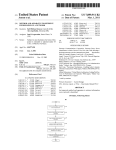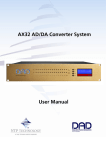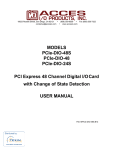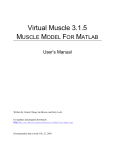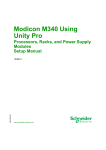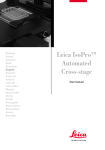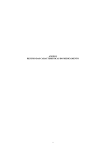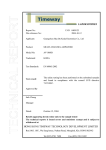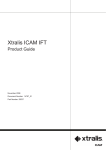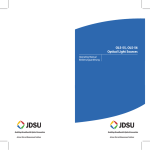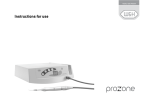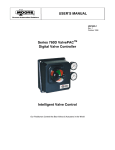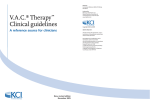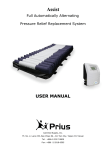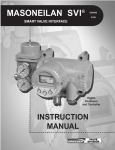Download Installation Guide
Transcript
Installation Guide AX32 AD/DA Converter System Installation Guide AX32 IMPORTANT SAFETY INSTRUCTIONS READ AND KEEP THESE INSTRUCTIONS WARNING – when using electric products, basic precautions should be followed, including the following: Read all of the safety and installations instructions and explanation of graphic symbols before using the product. 1. Do not use this apparatus near water. 2. Clean only with dry cloth. 3. Do not block any ventilation openings. Install in accordance with the manufacturer's instructions. 4. Do not install near any heat sources such as radiators, heat registers, stoves, or other apparatus (including amplifiers) that produce heat. 5. Do not defeat the safety purpose of the polarized or grounding-110 to 125V type plug according to UL 817 and CSA C22.2 no. 42. A polarized plug has two blades with one wider than the other. A grounding type plug has two blades and a third grounding prong. The wide blade or the third prong are provided for your safety. If the provided plug does not fit into your outlet, consult an electrician for replacement of the obsolete outlet. 6. Protect the power cord from being walked on or pinched particularly at plugs, convenience receptacles, and the point where they exit from the apparatus. 7. Only use attachments/accessories specified by the manufacturer. 8. Use only with the cart, stand, tripod, bracket, or table specified by the manufacturer, or sold with the apparatus. When a cart is used, use caution when moving the cart/apparatus combination to avoid injury from tip-over. 9. Unplug this apparatus during lightning storms or when unused for long periods of time. 10. Refer all servicing to qualified service personnel. Servicing is required when the apparatus has been damaged in any way, such as power-supply cord or plug is damaged, liquid has been spilled or objects have fallen into the apparatus, the apparatus has been exposed to rain or moisture, does not operate normally, or has been dropped. DANGER Improper connection of the equipment-grounding can result in a risk of electric shock. Do not modify the plug provided with the product – if it will not fit the outlet have a proper outlet installed by a qualified electrician. Do not use an adapter which defeats the function of the equipment-grounding conductor. If you are in doubt as to whether the product is properly grounded, check with a qualified serviceman or electrician. Doc no. AX32-8001-A-4 Rev. date 140107 Page 2 of 15 Installation Guide AX32 The product must be grounded. If it should malfunction or breakdown, grounding provides a path of least resistance for electric current to reduce the risk of electric shock. This product is equipped with a power supply cord having an equipment-grounding conductor and a grounding plug. The plug must be plugged into an appropriate outlet which is properly installed and grounded in accordance with all local codes and ordinances. WARNING • This product, either alone or in combination with an amplifier and speakers or headphones, may be capable of producing sound levels that could cause permanent hearing loss. Do not operate at a high volume level or at a level that is uncomfortable. If you experience any hearing loss or ringing in the ears, you should consult an audiologist. • The product should be located so that its location or position does not interfere with its proper ventilation. • The power-supply cord of the product should be unplugged from the outlet when left unused for a long period of time. When unplugging the power supply, do not pull on the cord, but grasp it by the plug. • Care should be taken so that objects do not fall and liquids are not spilled into the enclosure through openings. SERVICE • Do not attempt to service the product beyond that described in the user maintenance instructions. All other servicing should be referred to qualified service personnel. • The product should be serviced by qualified service personnel when: 1. 2. 3. 4. The power supply cord or plug has been damaged, or Objects have fallen, or liquid has spilled into the product, or The product has been exposed to rain, or The product does not appear to be operating normally or exhibits a marked change in performance, or 5. The product has been dropped, or the enclosure damaged. WARNING – Hazardous moving parts inside the unit. Keep fingers and other body parts away. Doc no. AX32-8001-A-4 Rev. date 140107 Page 3 of 15 Installation Guide AX32 Contents GENERAL DESCRIPTION. 5 Accessing the AX 32 cards. 5 BEFORE YOU START 5 Mechanical installation and low fan noise 5 Network configuration 5 CONTROL SOFTWARE INSTALLATION Computer recommendation 6 6 Program installation 6 Assigning the IP address for the computer and the AX32 6 OPERATION 8 Front panel LED’s 8 Front panel status display 9 Reconfig button 10 REAR PANEL CONNECTIONS. 11 Digital I/O Connections 11 Analogue I/O Connections 13 SPECIFICATIONS 14 Audio Specifications 14 Electrical Specifications: 15 Mechanical specifications 15 Environmental specifications. 15 © 2014 All rights reserved. DAD - Digital Audio Denmark is a registered Trademark of NTP Technology A/S, who is the legal owner of the brand. Product features and specifications are subject to change without notice. NTP Technology A/S shall not be liable for technical or editorial errors contained herein, nor for incidental or consequential damages resulting from the furnishing, performance or use of this manual. Company Address: NTP Technology A/S, Nybrovej 99, DK-2820 Gentofte, Denmark Fax. +45 44 53 11 70, E-mail: [email protected], Web: www.digitalaudio.dk. All trademarks are recognized as the property of their respective owners. Doc No. AX32-8001-A-4 rev.1 Doc no. AX32-8001-A-4 Rev. date 140110 Page 4 of 15 Installation Guide AX32 General description. Congratulations, and thank you for purchasing the DAD AX32 Converter System. AX32 is an extremely capable multi channel audio converter and microphone preamplifier for independent simultaneous analogto-digital (A/D), and digital-to-analog (D/A) conversion as well as digital-to-digital (D/D) format conversion and signal routing. The AX32 has as standard 8 stereo AES3 inputs and outputs (16 I/O channels), dual DigiLink™ interface for 64 input and output channels to Pro Tools™ HDX and one coaxial 64-channel MADI input and output connection. The AX32 can be fitted with up to 6 pcs. 8-channel A/D or 8-channel D/A cards, providing for up to 48 analogue input or output channels. Digital interface options include up to 2 optical MADI 64-channel input and output connections and a 64-channel IP Audio interface power by Dante™. The AX32 is equipped with one power supply, except when configured with 6 analogue cards in which case a second power supply is installed. It is also possible to add a the second power supply as a redundant power supply when less than 6 cards are installed. This installation guide provides basic information about the installation and use of the AX32. For more detailed information please refer to the AX32 user manual available on the DAD website, www.digitalaudio.dk. Accessing the AX 32 cards. It is not necessary to open the AX32 during installation, unless you need to add extra A/D or D/A cards. The AX32 cards and module options can be accessed by removing the lid of the AX32 chassis. The chassis provides 8 card slot positions, where six can be used for analogue cards. It is important that the placement of the cards are maintained since they correspond to the configuration of the unit. The mini I/O module and the IP Audio option are mounted on the Main board of the converter. Cards and modules should not be removed or changed without consulting either NTP Technology or an authorised DAD representative. Before you start Place your AX32 on a hard and dry surface or mount it into a 19” rack, and leave plenty of room for ventilation. In order to meet the EMC requirements of directives EN 55103 and FCC 47 CFR part 15, and in order to obtain the highest performance of the AX32, you must use good quality correctly shielded cables for all external connections when installing the AX32. For the power connection, a normal unshielded power cable with a proper protective earth conductor can be used. Make sure that your sound system is at a safe volume level. Mechanical installation and low fan noise The AX32 is fitted with two ultra-quiet fans to ensure optimum operating temperature. The fans are temperature-controlled, i.e. the rotation speed, and thereby noise, is dependent on the temperature inside the AX32. The fans are hardly audible during normal operation, assuming the AX32 is installed correctly. The optimal air flow is from the front holes in the bottom of the unit to the rear holes in the rear and top plate. When the unit is installed, considerations have to be made to ensure proper air circulation from the bottom to the rear. It is recommended to leave 1RU of space free under the AX32 and not to block the rear panel and top plate holes. The speed of the two low noise fans will be increased automatically to keep the internal temperature low if there is insufficient airflow. If the internal temperature exceeds 60ºC / 140ºF a temperature alarm will appear in the display. Please refer to the mechanical specifications section for more details regarding the installation. Network configuration AX32 is equipped with two GigaBit Ethernet connectors and internally an Ethernet switch, a controller part and a part for the optional IP Audio option powered by Dante™. The network connectors can operate as Doc no. AX32-8001-A-4 Rev. date 140110 Page 5 of 15 Installation Guide AX32 two “parallel” connectors for the internal switch, or as dual connectors for redundant IP audio operation. In this case controlling the unit is done via Net port 1. AX32 has one to tree different IP addresses. One for the unit control via DADman and one or two for the IP audio in respectively single or redundant mode. The network configuration is managed separately for the controlling interface and for the IP audio interface, and can have different configuration. The controlling interface is used for controlling AX32 from DADman and the IP audio interface (one or two if installed) is used for interfacing IP audio in a network. The factory default setting of the IP address of the controller port of the AX32 is 10.0.7.20. The IP address can be changed manually via DADman or it can be set to be automatically assigned by a DHCP server/router in the network. If needed AX32 can be set in recovery mode with a the fixed factory defined IP address 10.0.7.20 and IP discovery via DHCP. This is described in the Reconfig section of this manual. For a more detailed description of the network functionality, configuration, and behaviour please refer to the separate AX32 user manual. Control software installation Computer recommendation The DADman control program operates on any Windows or MAC-OSX based computer, and is constantly maintained for interoperability with the latest OS versions. Program installation This section will take you through the installation procedure for the DADman computer control program. The AX32 is controlled from a PC or MAC using a network connection. The PC/MAC and the AX32 units must be connected on the same subnet. The DADman remote control program 1. Install the DADman program by downloading the application from www.digitalaudio.dk. Follow the instructions of the install program. Please note that there are two different program downloads; One for Windows and one for MAC-OSX. 2. Create a shortcut for the DADman program on the desktop. 3. Double-click on the DADman icon and start the DADman application. 4. Connect one (only one) AX32 to the network 5. In the top menu bar select Tools/Device List and apply ‘Refresh’ when using a Windows PC, in order to discover the AX32 on the network. On MAC-OSX ‘Action’ is used to select ‘Refresh IP list’ The Device List window for Windows and MAC-OSX is show in figure 1. Assigning the IP address for the computer and the AX32 When the DADman program is installed you are able to finalise the network configuration of the AX32 by connecting AX32 one by one. You have the option of using fixed IP addresses or IP addresses assigned via DHCP. Fixed IP address You must have a preferred range of IP addresses, and a network mask for the computer network and the connected AX32 units. 1. Configure your computer IP address and network mask via the computer control panel to e.g. 10.0.7.25 | 255.255.255.0 2. Select the AX32 in the DADman Settings/ Device List menu by right clicking the unit line and select ‘Network settings’ when using a Windows PC. On MAC-OSX you use the ‘Action’ button to select ‘Network Settings’. 3. Configure via DADman each AX32 in turn with a unique IP address and the preferred network mask e.g. 10.0.7.21 | 255.255.255.0. In this window you can also configure the IP audio network settings Doc no. AX32-8001-A-4 Rev. date 140110 Page 6 of 15 Installation Guide AX32 4. When you are done you can connect more than one AX32 to the network, and they will appear in the DADman Device List. Automatic IP address You must have a network with a DHCP server which will allocate the IP addresses. 1. Configure your computer IP address via the computer control panel to DHCP. 2. Select the AX32 in the DADman Tools / Device List menu by right clicking the unit line and select ‘Network settings’. 3. Configure via DADman each AX32 in turn to DCHP. 4. When you are done you can connect more than one AX32 to the network, and they will appear in the DADman Device List. Figure 1, DADman Device list in Windows Figure 2, DADman Device list in MAC-OSX Doc no. AX32-8001-A-4 Rev. date 140110 Page 7 of 15 Installation Guide AX32 For a more detailed description of the DADman software please refer to the AX32 user manual available on the DAD website, www.digitalaudio.dk Note. In order to have proper function of the AX32 the router and sample rate configuration has to be set correctly via DADman. Operation The AX32 is controlled via the DADman software and some simple control and status viewing can be made via the front panel of the unit. The DADman control program interfaces to the unit via one of the rear panel Ethernet connectors. On the front panel two rows of LED indicators are available for indication of the AD and DA signal level, an LCD display is available for simple control and for showing various settings of the AX32. 4 buttons are available for accessing the settings shown in the display. Figure 3, Front panel layout Front panel layout 1. 16 LED indicators for signal level indication of the analogue AD input. 2. 16 LED indicators for signal level indication of the analogue DA output. 3. 4 buttons for operating the status display. 4. Status display. Front panel LED’s AX32 has two rows of 16 LED indicators on the front panel showing the signal status for the AD inputs and DA outputs. Doc no. AX32-8001-A-4 AD OL/signal Signal of AD channel 1-16. Yellow indicates signal input above -42dB FS, and red indicates signal above -0.5 dB FS. DA Signal/carrier Signal of DA channel 1-16. Yellow indicates signal input above -42dB FS, and green indicates signal below -42dB FS and a valid digital input source/carrier. Rev. date 140110 Page 8 of 15 Installation Guide AX32 Front panel status display The display of the AX32 has four rows for displaying information and four knobs for entering and scrolling information. The display can show more pages and each page can consist of rows where settings can be changed, and with rows for just showing status information. The display functions for the basic page are described below. More pages are available depending on the firmware version of the AX32. For more information on these pages please refer to the user manual. Operating buttons Setting Pushing the button scrolls trough the settings rows. The > curser marks the selected row/function. Up Pushing the button scrolls up the value/ setting of the selected function. Down Pushing the button scrolls down value/setting of the selected function. Page Pushing the button scrolls trough the available display pages. the Basic display page – sample rate, synchronization, ID and alarms Sample Rate Shows sample rate of the AX32. If an asterisk * is shown the sample rate is controlled via an external digital audio interface. SRate Adapt Shows which external digital audio interface that controls the sample rate or shows “Intern” for internal sample rate control. Sync Source Shows the external synchronisation clock source or shows “Intern” when the AX32 uses the internal clock. Unit ID /Name Shows unit ID number and unit name. This is set via DADman. Alarm/status Shows alarm status: Sync OK = Clock sync is OK SyncErr = Clock sync failure TempErr = temperature inside AX32 is above 60ºC / 140ºF. Check that the AX32 is installed in accordance with the instructions. Fan Err = One of the two fans is not working correctly. Contact a DAD representative or the factory. CardErr = Fault in one of the A/D or D/A cards. Contact a DAD representative or the factory. Psu Err = Power supply failure. Contact a DAD representative or the factory. Doc no. AX32-8001-A-4 Rev. date 140110 Page 9 of 15 Installation Guide AX32 Reconfig button The “Reconfig” button on the back of the AX32 should not be used during normal installation. It is generally intended as an ultimate recovery function in case something goes wrong during programming of IP addresses or a software upgrade, e.g. an unintended power loss. It allows the AX32 to start in various “basic” modes so it can be restored without having to be returned to the factory. The “Reconfig” button is accessed via a hole in the rear panel using a pen or a similar pointed item. A green LED is visible through the hole. When the “Reconfig” button is activated, the LED will light up indicating the two reconfig modes of the AX32. Recovery mode “Reconfig” pushed while the unit is powering up Green LED turns ON The AX32 enters a recovery mode. In this mode only a basic boot software is operative in the unit, and new software can be downloaded via the DADman software. This mode is used if the software in the AX32 for some reason is not operative or broken. The IP address settings of the unit are the last setting used in the unit. “Reconfig” short push while the unit is in reconfig mode and Green LED is on The AX32 remains in reconfig mode as described above. The IP address settings of the unit is however set to DHCP. In case there is no DHCP server on the network, the AX32 will default to IP address 10.0.7.20 / 255.255.0.0 after approx. 2 minutes. Green LED turns OFF The selection of either of the two recovery modes are fixed after selection. The AX32 will start with a basic boot software and IP configuration. The AX32 will not be operational until a proper firmware has been downloaded via the DADman software and it has been restarted. By enabling recovery mode with default IP address and network configuration the unit can always be identified on a network via the default setup. Note that the IP address referred to is the IP address of the controller/management interface of the unit. This is not the IP address of the IP audio interface if a such is installed. This IP address can not be accessed in recovery or restore defaults mode. Restore defaults Push “Reconfig” for 10 sec. while the unit is in normal operation. Release “Reconfig” button Green LED OFF Doc no. AX32-8001-A-4 The AX32 enters a restore default mode. In this mode all setting of the unit is initialized to the factory programmed defaults. The IP address settings of the unit are remain unchanged and do NOT return to factory default. When the “Reconfig” button is released the firmware of the unit restarts with the factory default settings and enter normal operation automatically. Rev. date 140110 Page 10 of 15 Installation Guide AX32 Rear panel connections. Figure 4, Rear panel layout Rear panel layout 1. Card slot 1 to card slot 8. 25 pole female D-sub connector with Tascam pin-out. Up to 6 pcs. 8channel analogue input or output cards can be installed. Slots 2 and 6 are currently not used. 2. Mini module slot for dual optical MADI I/O via SFP. 3. Power switch. 4. Mains inlet. The same mains inlet is used even when a redundant power supply is installed. 5. AES/EBU I/O channels 1-4. 25 pole female D-sub connector with Tascam pin-out. 6. AES/EBU I/O channels 5-8. 25 pole female D-sub connector with Tascam pin-out. 7. MADI I/O BNC connectors. 8. DigiLink™interface port for Pro Tools™HDX, Primary port. 9. DigiLink™interface port for Pro Tools™HDX, Primary port or Expansion port (configurable). 10. Word Clock or Video Black Burst synchronization input (configurable), BNC connector. 11. Word Clock synchronization output BNC connector. 12. AES11/AES3 synchronization input, female XLR connector. 13. Ethernet control and IP audio Primary port (net 1) RJ45 connector. Control port in redundant IP audio mode. 14. Ethernet control and IP audio Secondary port (net 2) RJ45 connector 15. Reconfigure button, and status LED Digital I/O Connections Dual MADI SFP optical I/O mini-module The Dual SFP optical module, can be installed with one or two “Small form-factor pluggable” (SFP) transceiver modules. The SFP modules are standard types which support various types of optical interfaces with LED or Laser diodes, various wavelengths and fibertypes. Each SFP module has a receiver and a transmitter part, and can be used for MADI audio I/O. Doc no. AX32-8001-A-4 Rev. date 140110 Page 11 of 15 Installation Guide AX32 The right part of the SFP connector is the receiver and the left part is the transmitter. AES11 Sync input, Female XLR connector Pin 1. TX. + Pin 2. TX. – Pin 3. RX. + Ethernet, RJ45 connector, Gigabit Pin 1. BI_DA+ Pin 2. BI_DA- Pin 3. BI_DB+ Pin 4. BI_DC+ Pin 5. BI_DC- Pin 6. BI_DB- Pin 7. BI_DD+ Pin 8. BI_DD- AES/EBU I/O 25 pole female D-sub connectors The top connector provides the connection for AES/EBU I/O channels 1-4. The lower connector provides the connection for AES/EBU I/O channels 5-8, providing a total of 8 AES/EBU I/O channels. Below is listed the connections for the combined input and output 25 pole D-sub connector. The pinning is according to the proprietary standard by the company Tascam. Connections channel 1-4 / channel 5-8 Pin out Doc no. AX32-8001-A-4 Pin no Func. Pin no Func. 1 DOUT 4/8 + 14 DOUT 4/8 - 2 GND 15 DOUT 3/7 + 3 DOUT 3/7 - 16 GND 4 DOUT 2/6 + 17 DOUT 2/6 - 5 GND 18 DOUT 1/5 + 6 DOUT 1/5 - 19 GND 7 DIN 4/8 + 20 DIN 4/8 - 8 GND 21 DIN 3/7 + 9 DIN 3/7 - 22 GND 10 DIN 2/6 + 23 DIN 2/6 - 11 GND 24 DIN 1/5 + 12 DIN 1/5- 25 GND 13 N.C. Rev. date 140110 Page 12 of 15 Installation Guide AX32 Analogue I/O Connections Analogue I/O 25 pole female D-sub connectors. There are three types of optional analogue card for the AX32: • CARD-AX32-L8, 8 ch. Line AD Card • CARD-AX32-M8, 8 ch. Mic/Line AD Card • CARD-AX32-DA8, 8 ch. Line DA Card These are interfaced via a 25 pole D-sub connectors on the card which is accessible from the rear panel of the AX32 chassis. This connector type is used both for the analogue input card and for the analogue output card. Below is listed the connection for the 25 pole D-sub connector. The pinning is according to the proprietary standard by the company Tascam. For more a detailed description of the two cards please refer to the AX32 user manual. Connections channel 1-8 Pin out Doc no. AX32-8001-A-4 Pin no Func. Pin no Func. 1 AIN/OUT 8 + 14 AIN/OUT 8 - 2 GND 15 A/IN/OUT 7 + 3 AIN/OUT 7 - 16 GND 4 AIN/OUT 6 + 17 AIN/OUT 6 - 5 GND 18 AIN/OUT 5 + 6 AIN/OUT 5 - 19 GND 7 AIN/OUT 4 + 20 AIN/OUT 4 - 8 GND 21 AIN/OUT 3 + 9 AIN/OUT 3 - 22 GND 10 AIN/OUT 2 + 23 AIN/OUT 2 - 11 GND 24 AIN/OUT 1 + 12 AIN/OUT 1- 25 GND 13 N.C. Rev. date 140110 Page 13 of 15 Installation Guide AX32 Specifications Audio Specifications Analogue input Sampling, resolution 5bit sigma/[email protected] or 6.144 MHz, 24 bit PCM PCM (DXD) sample rates 44,1, 48, 88.2, 96, 174.4, 192, 352.8, 384 kHz DSD sample rates 2.8224 & 5.6448 Mhz (64 & 128 fs) Dynamic range (A) > 123 dB THD+N(A) < -117 dB@-3dB FS / 0,00014% Cross talk < -120 dB Input Impedance (differential) > 10 k Ohm Max input level Adjustable from 9 dBu to 30 dBu in steps of 0.1 dB Microphone input gain range/accuracy Adjustable from -18 to +70 dB, in steps of 0.1 dB, ± 0.25 dB accuracy Microphone equivalent input noise (A) < -133dB Analogue output Modulator resolution, format 32 x oversampling, 1 bit DSD, 24 bit PCM PCM (DXD) sample rates 44,1, 48, 88.2, 96, 174.4, 192, 352.8, 384 kHz DSD sample rates 2.8224 & 5.6448 Mhz (64 & 128 fs) Dynamic range (A) > 128 dB THD+N(A) < -110 dB@-3dB FS / 0,00031% Cross talk < 120 dB Max output level Adjustable from -60 dBu to 24 dBu in steps of 0.1 dB Digital I/O and Synchronisation Digital I/O formats/ Supported sample rate AES/EBU, Pro Tools™ DigiLink™, Dante™ IP Audio/up to 192 kHz.MADI / up to 384 kHz and DSD Synchronisation/sample rate AES11, Word Clock, All digital inputs, Video Sync (word clock connector)/ PAL, NTSC, SECAM Network Interface Interface Doc no. AX32-8001-A-4 1000BASE-T, RJ45 connector, 4-pair connection Rev. date 140110 Page 14 of 15 Installation Guide AX32 Electrical Specifications: Power consumption 90 VA max. Input voltage 90 – 260 VAC 100 – 240 VAC Nominal, 47 - 63 Hz Mains fuse, mounted in IEC connector 1 A, T1AH/250V Safety compliance EN 60950-1:2006 Power supply cord must be min. light sheathed flexible cord according to IEC60227 (designation 60227 IEC 52) and include a protective earth conductor having a green-and-yellow insulation. Cross-sectional areas min. 3x0.75mm2” Mains line plug type Correct type acc. to standard 110-125V UL817 and CSA C22.2 no 42 220-230V CEE 7 page VII, SR section 107-2-D1/IEC 83 page C4. 240V BS 1363 of 1984.Specification for 13A fused plugs and switched and unswitched socket outlets Mechanical specifications Chassis standard 19”, 2 RU Chassis depth, without connectors mounted 35.0 cm / 13.8” Chassis body width 43.5 cm / 17.2” Weight, not including I/O cards 5 kg / 11 lbs. Chassis air flow from front to rear Environmental specifications. Operating Temperature 0 – 45 ºC / 32 - 113ºF Humidity EMC compliance EN 55103-1, part 1: emission EN 55103-2, part 2: Immunity FCC 47 CFR part 15 (B): emission Doc no. AX32-8001-A-4 Rev. date 140110 Page 15 of 15















